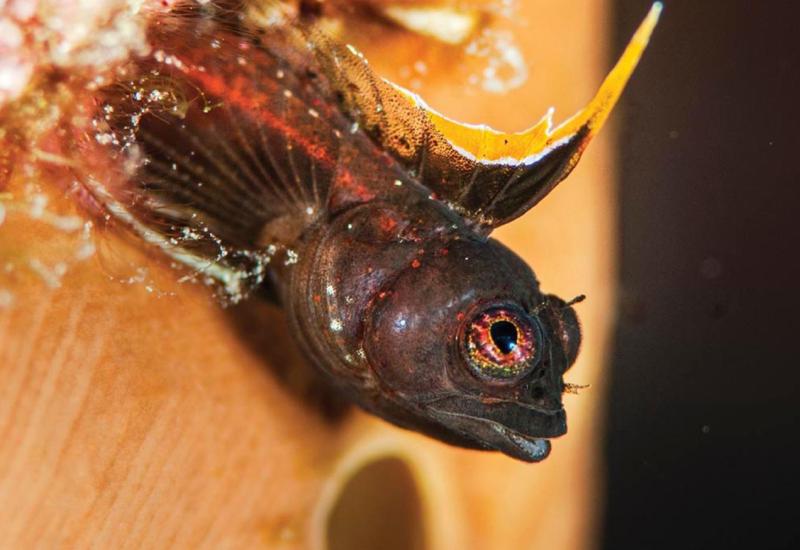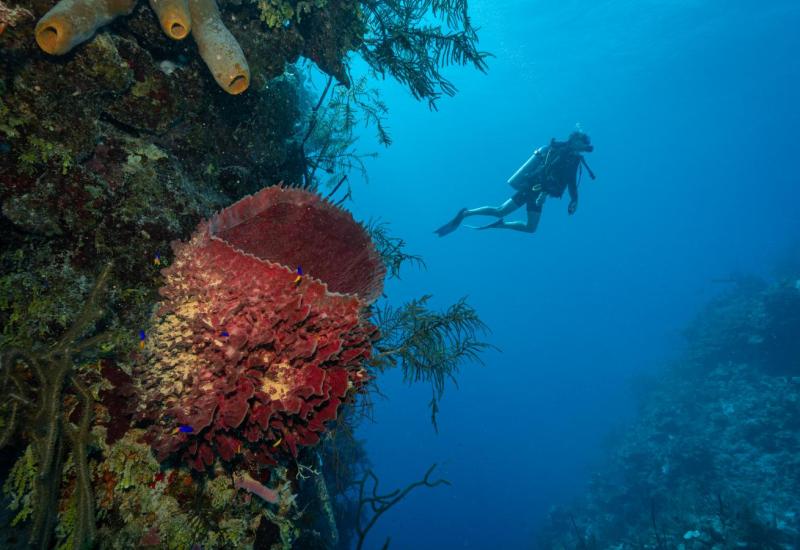Camera-Ready in the Cayman Islands

Text & Photography by Stephen Frink
With a treasure chest of photogenic riches, the Cayman Islands are a multifaceted destination for underwater photographers.
Cataclysmic volcanic activity 60 million years ago helped create a rich dive photography environment. By accident of nature, the presence of the Cayman Trench means spectacular vertical walls, the signature feature of all three Cayman Islands--Grand Cayman, Little Cayman and Cayman Brac. Because of the islands' volcanic substrate, there are no rivers to degrade visibility, contributing to stellar water clarity.
The legacy of marine conservation and fish familiarity with divers makes fish remarkably approachable. With average visibility between 80 and 120 feet, there's minimal backscatter, making creative lighting easier and more dramatic. Healthy reefs create myriad photo ops for environmental marine life portraits. Shipwrecks in shallow water are plenty fishy and the large machinery of some vessels provides for dramatic foregrounds with diver silhouettes in the distant background. The opportunities are there for positioning dive models to illustrate perspective.
With this abundance of walls, shallow reefs, shipwrecks and camera-friendly marine life, the Cayman Islands has a wealth of photographic potential you just can't swim away from. So read on, heed the accompanying tips and prime your camera for capturing underwater images you've always dreamed of, at 25 stellar dive sites.
Grand Cayman
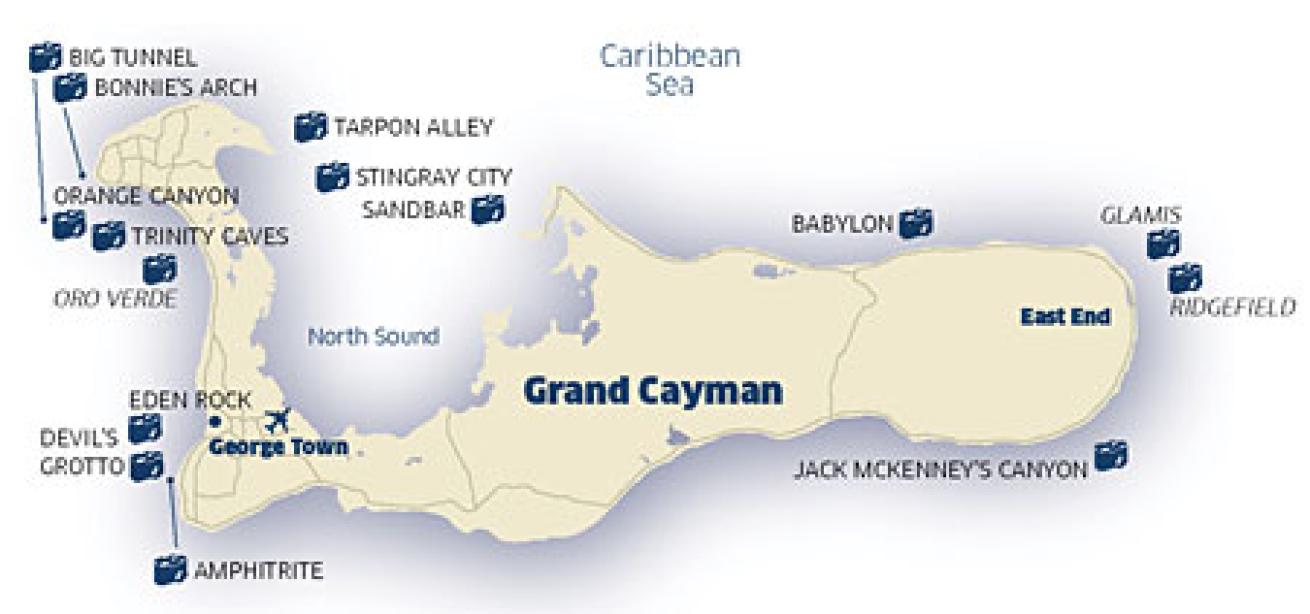
Stingray City & Sandbar
Local fishermen used to drop in here, behind the reef line off South Sound, to clean their catches, throwing the debris overboard, which was then sucked up by a resident crowd of stingrays. A prescient dive guide envisioned an opportunity for divers to dive with them, in only 12 feet of water. Stingray City was born.
Today, the phenomenon remains unmatched by any other island, anywhere, with dozens of stingrays and high-profile coral heads begging for your camera's attention. Using just a few bits of bait, talented ray wranglers coax quite an aquatic ballet from the rays, making a prolonged and highly productive photography session. Another nearby area, the Sandbar, rises to within only a few feet of the surface. It's an excellent backdrop for over/under shots of the rays because of its bright white sand and turquoise water.
Walls
Grand Cayman's undersea cliffs are quite diverse to a photographer's eye and substantially different along the island's east, west and north shores. While the south coast's walls are deep and seldom visited except by technical divers, the North Wall is Mecca for wall divers, with some 45 named sites visited by most local dive operators.
One, Babylon, is mythically popular--and rightly so, for its impressively decorated pinnacle. Large black coral trees and deep-water gorgonians blur the pinnacle's texture, while orange elephant ear and crimson strawberry sponges provide kaleidoscopic punctuation.
The West Wall is protected by prevailing winds, so it's often as calm as a lake, and divers can explore Orange Canyon, Trinity Caves or Big Tunnel. These are calm, effortless dives with healthy sponges and seasonal concentrations of silversides, complete with attendant predators, such as tarpon and black groupers.
The East Wall is a bit more weather-exposed, but sites like Jack McKenney's Canyon, known for its deep canyons, sharks and eagle rays, are only a short boat ride from shore. The average visibility along the wall tends to be a bit better than on the west side, and divers are often rewarded with sightings of Caribbean reef sharks. But the real and guaranteed thrill of East End is being one of the only divers there.
Fish
The prized--and perhaps most challenging--shots here, in several sites, are of tarpon. At Tarpon Alley, the upside is that there are massive amounts of them in the sand channels, where you can capture anywhere from 30 to 50 in a frame. Proximity to the fish is easy, but taming their highly reflective scales is tough. The downside is that tarpon are difficult to photograph because their silvery color is mirror-like when parallel to the sensor plane, making it hard to get your exposures right. The solution? Shoot at a 20- to 60-degree angle, so only some of the light reflects back to you. Because of the volume and proximity of the fish, you can experiment.
At Bonnie's Arch, it's best to dive in a small group if you're trying for a dramatic photograph of a tarpon under an arch. With the right application of strobe, you can employ the diver as an element of composition in foreground, with reef colors and angelfish in the background. When the silversides are thick at the adjacent sites, Devil's Grotto and Eden Rock, tarpon and groupers incessantly gorge themselves, creating a magic display accentuated by the spectacular cathedral lighting within their swim-throughs.
Wrecks
The Oro Verde, a 189-foot island freighter sunk in 1980, has been flattened and scattered by decades of swells and hurricanes. But with a legacy of fish feeding there, she still holds plenty of marine life, including groupers and angelfish. While photographing the ship, you can put its portholes in the foreground and divers in background. Its fishiness makes it easy to get great marine life portraits.
Off Grand Cayman's East End, there's the Glamis, one of the Cayman Islands' most historic wrecks. With not many hiding places for fish, it's not particularly fishy, so its two anchors are the primary visual hooks for your lens. Using divers in the background of the anchor shots gives size and perspective. The Ridgefield is fairly close to the Glamis and is in shallow water, but the weather doesn't always cooperate with divers wanting to visit. On rough days, it doesn't take much of a swell to stir up a sandy bottom at 15 feet. If you dive there, the vessel's big drive shaft and massive propeller help convey perspective distortion in the foreground for a diver silhouette shot.
Little Cayman
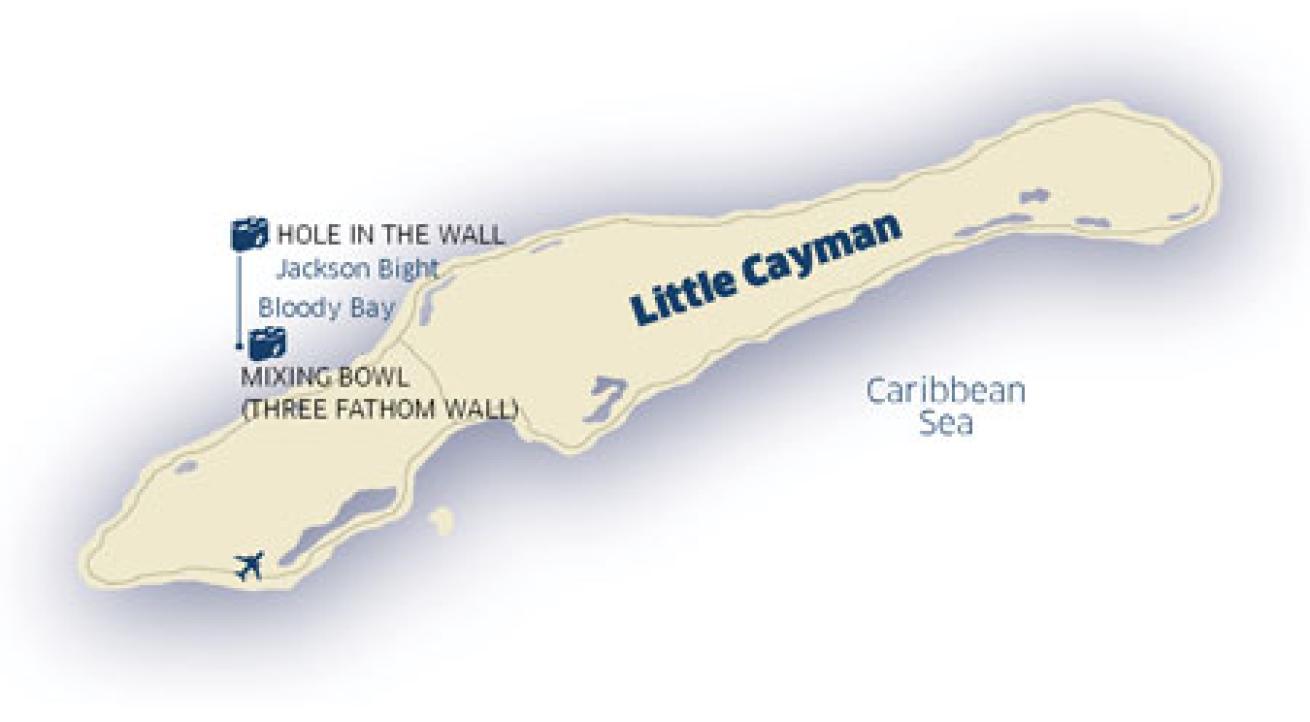
Walls
There are several dozen extraordinary wall dives along Bloody Bay and Jackson Bight, and because they start in shallow water, you can shoot dramatic sponge formations on the vertical wall and work your way up to the top where there's lots of life between 18 and 24 feet. You can take the last 20 minutes of your dives to work along the reef flats and get wide-angle and macro shots while off-gassing.
Three Fathom Wall starts in only 18 feet of water and vertically plunges far beyond recreational diving limits. While there's a feeling of exhilaration free-falling into the blue, there's plenty of wide-angle fascination to arrest your descent--massive orange elephant ear sponges growing parallel to the face of the wall, and tube, rope and encrusting sponges of rich red, lavender and yellow, so you'll need to close down your aperture a stop to properly expose them.
There are also chimneys choked with black coral--perfect for diver silhouettes--and the coral buttresses of Jackson Bight that rise in stark relief to the blinding white sand plateaus patrolled by symbiotic duos of stingrays and jacks.
Fish
Mixing Bowl (Three Fathom Wall) is one of Bloody Bay Wall's shallowest and fishiest areas, where schools of blue-striped grunts and squirrelfish congregate. Your camera can capture the alluring contrast between the red of the squirrelfish and the lavender of nearby sea fans. In the big sandy plateaus of Jackson Bight, the black and white spots of spotted eagle rays make a striking photographic contrast against pure white sand. Preset your strobe and aperture, control your breathing and carefully approach them. If you're diving Hole in the Wall, the shallows are great for photographing tame Nassau groupers that willingly pose for that close-focus, wide-angle composition.
Cayman Brac
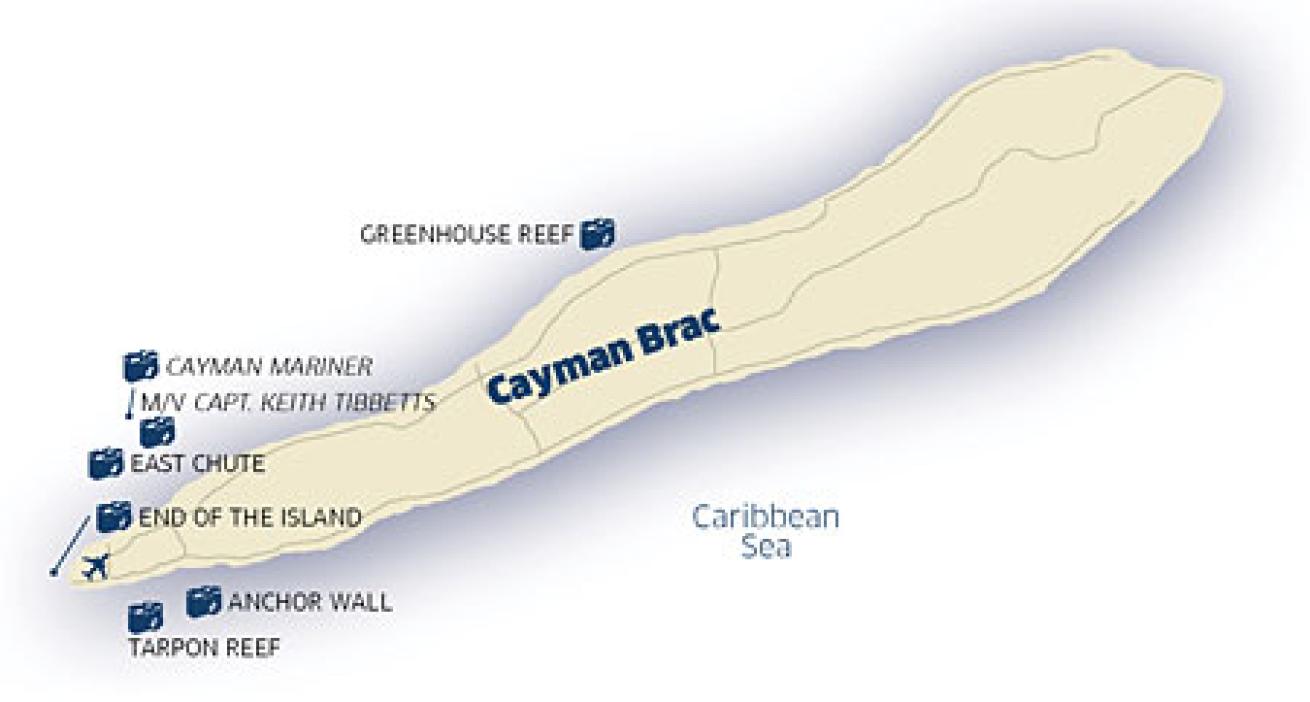
Wrecks
The M/V Capt. Keith Tibbetts, sunk 12 years ago, is by far the Cayman Islands' most popular artificial reef. She's a 330-foot-long former Russian military vessel that finished her career as a Cuban warship.
While she originally sat upright, years of storm and electrolytic degradation allowed her to corkscrew onto her port side at the bow, although the stern still sits squarely in the sand. The stern of the Tibbetts is in about 30 feet of water, so you have more ambient light for photography. Use strobe fill to accentuate whatever is there. The bow is heavily sponge-encrusted and fire coral coats the guns. Best results come from blending the strobe with ambient light and choosing a shutter speed that allows sufficient ambient light on the scene.
The high-profile features are gun turrets, fore and aft, and the fish she holds. There has been a resident goliath grouper here, but groupers come and go as breeding seasons dictate. Colorful sponges cloak the ship's ribs and decorate her bow railings.
Walls
Sites like East Chute are deep, beginning at around 70 feet. The massive spur-and-groove sand chute that gives the site its name breaks from a slope to a vertical drop at about 110 feet, but underwater photographers are rewarded with a very colorful, coral-encrusted, small shipwreck, the Cayman Mariner, in only 55 feet, perfect for shooting on the way back to the boat.
Anchor Wall is another must-dive Cayman Brac wall, not only for the colorful sponges decorating the seaward face, but for the massive anchor embedded directly into a wall crevice just 4 feet above the crevice floor at 100 feet. The anchor itself is about 7 feet high and 6 feet across at the flukes. There's no other wreckage, or even an anchor chain, nearby. The orange encrusting sponge that now cloaks the anchor makes for terrific images, but because of the overhead environment, both photographers and models must exhibit good buoyancy and work quickly before their exhalation bubbles cause the site to silt out.
Fish
With the shallow reefs here, you've got ample time and ample light to photograph the marine life. Healthy coral backgrounds provide stunning environments for fish portraits. Tropical fish against star corals and encrusting red sponges are far superior to sterile fish ID shots.
At Tarpon Reef, the ledges in the huge spur-and-groove formations shelter marine life. You can kneel in the sand without impacting fragile corals and still get good environmental fish portraits. As long as you're careful with your approach, you can get closer to the fish, which can increase color and resolution in your photographs. Greenhouse Reef is an excellent place to photograph flying gurnards, the unusual, bottom-dwelling fish with colorful pectoral fins. End of the Island, meanwhile, offers clear water, friendly French and queen angelfish and big schools of grunts.
Our Thanks
Grand Cayman
Cobalt Coast Resort & Suites/Divetech: cobaltcoast.com, divetech.com
Compass Point Dive Resort/Ocean Frontiers: compasspoint.ky, oceanfrontiers.com
Sunset House/Sunset Divers: sunsethouse.com/sdm
Little Cayman
Little Cayman Beach Resort/Reef Divers: littlecayman.com
Paradise Villas: paradisevillas.com

Cayman Islands Resources
Grand Cayman
Divetech/Cobalt Coast
888-946-5656
divetech.com
Red Sail Sports
877-RED-SAIL
redsailcayman.com
Don Foster's Dive Cayman
800-83-DIVER
donfosters.com
Ocean Frontiers/Compass Point
800-348-6096
oceanfrontiers.com
Sunset House
800-854-4767
sunsethouse.com
Little Cayman
Little Cayman Beach Resort
800-327-3835
littlecayman.com
The Club at Little Cayman
800-327-3835
theclubatlittlecayman.com
Conch Club Condominiums
888-756-7400
conchclub.com
Southern Cross Club
800-899-2582
southerncrossclub.com
Paradise Villas
877-322-9626
paradisevillas.com
Cayman Brac
Carib Sands/Brac Caribbean
866-843-2722
866thebrac.com
Brac Reef Beach Resort
800-594-0843
bracreef.com
Tourism
Sister Islands Tourism Association
sisterislands.com
Cayman Islands Tourism Association
cita.ky
Cayman Islands Department of Tourism divecayman.ky
Live-Aboard
Cayman Aggressor IV
800-348-2628
aggressor.com
Wholesalers
Bay Adventures
888-599-3483
bayadventures.com
Caradonna Dive Adventures
800-328-2288
caradonna.com/Destination/CaymanIslands.aspx

InDepth
Dive Conditions: The average water temperature is between 79 and 83 degrees, and the visibility is a reliable 70 feet, sometimes exceeding 100 feet.
Weather: The Cayman Islands' tropical climate is cooled by trade winds in winter; the rain picks up in summer months, but it usually appears in brief spurts. Temperatures generally range from 75 to 85 degrees, with highs up to 90 in the summer.
Getting There: Scheduled flights to Grand Cayman's Owen Roberts International Airport are available on Cayman Airways, Air Canada, Air Jamaica, American Airlines, British Airways, Continental Airlines, Delta Airlines, Northwest Airlines and US Airways. Cayman Brac also has its own airport, Gerrard Smith International. Little Cayman is served by daily inter-island flights.
Getting Around: Renting a car is a must if you want to explore Grand Cayman. Most of the big chains have offices at the airport. The Cayman Islands tourism web site, caymanislands.ky, has a link to car rental agencies. For car rental options on Cayman Brac check out bandsmv.com and cbrentacar.com. A car is less of a necessity on Little Cayman, where, in most cases, a bike is all you'll need. To rent a car on any of the islands, you'll need a US$9.50 temporary driver's permit.
Documents: U.S. visitors need a valid passport. Keep the immigration slip issued to you--you'll need to return it upon your departure. There is a US$25 departure tax, usually included in the price of your airline ticket.
Time: Eastern Standard Time year-round; Daylight Saving Time is not observed.
Telephone: The area code is 345.
Currency: The Cayman Islands dollar (CI) is on a fixed exchange rate: CI$1 is equal to US$1.25.
For More Information: Cayman Islands Tourism Association, cita.ky; Sister Islands Tourism Association, sisterislands.com; Cayman Islands Department of Tourism, divecayman.ky.


